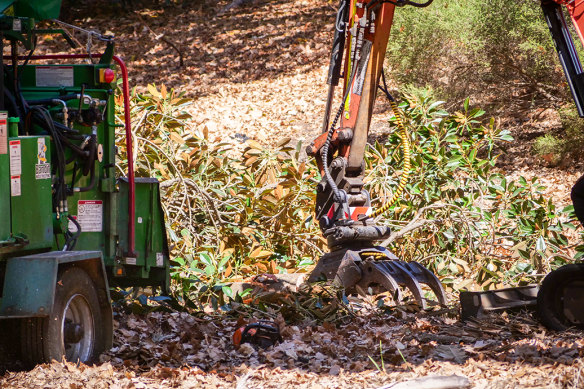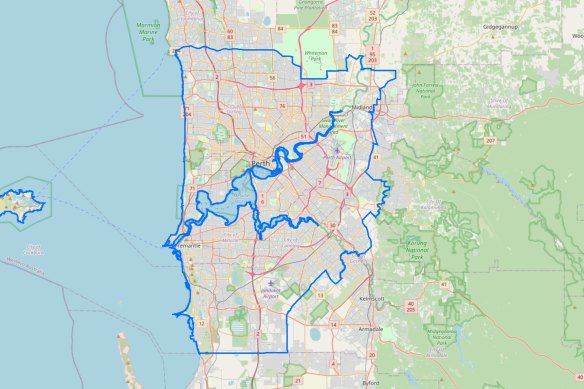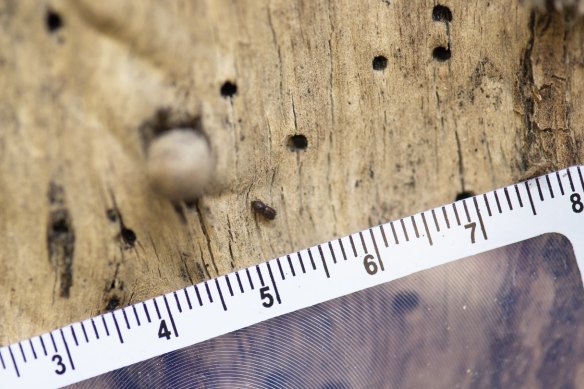- Exclusive
- Politics
- WA
- Environmental protection
Perth Zoo, Rottnest trees felled as borer spreads through 88 suburbs
By Hamish Hastie
More than 3000 of Perth’s trees, now including Perth Zoo and Rottnest Island’s, have been destroyed as one of the state’s biggest-ever biosecurity operation ramps up.
The trees were felled to stop the spread of the polyphagous shot-hole borer, in the biggest-ever biosecurity operation undertaken by the state government.

Infected trees are cut down in Kings Park. Credit: DPIRD
Figures up to mid-May that the Department of Primary Industries and Regional Development provided to WAtoday lay out the shocking destruction wreaked by the South East Asian pest, which kills trees via boring holds in trees, in which it plants a fungus that it plants and farms for food – but which stops trees transferring nutrients, slowly killing them.
By mid-May department officers had inspected more than 1.75 million trees on more than 60,000 properties, clocking up more than one million kilometres between them.
This has resulted in the destruction of thousands, including beloved exotic species such as figs and London plane trees, in cherished public spaces like Hyde Park and King’s Park.
WAtoday can also reveal that by last month the borer had been detected in 15 trees on Rottnest Island, resulting in two being mulched and 11 pruned.
At Perth Zoo, the borer has been detected in 155 trees; 73 have been mulched, while 76 have been pruned.
Vincent Lanoiselet, the department’s chief plant biosecurity officer, said they were collaborating with the Rottnest Island Authority and Perth Zoo to stem the spread.
“[The pest] was detected at the Perth Zoo and Rottnest Island early in the response and [the department] has been working with stakeholders to manage affected trees,” he said.
“Surveillance and tree treatments, including removal and pruning, are being completed collaboratively with Perth Zoo and Rottnest Island Authority staff, to limit the spread of PSHB, while considering animal welfare and visitor experience.

The Perth quarantine area (full map available on Department of Primary Industries and Regional Development website). Credit: Department of Primary Industries and Regional Development's Agriculture and Food division
“The vast majority of trees on Wadjemup/Rottnest Island are Australian natives, which appear to be less susceptible to borer attack.”
Lanoiselet said the department’s surveillance effort was the biggest in the department’s history thanks to a $41 million nationally funded eradication program.
“If [shot-hole borer] were to become established in WA, it could significantly impact on our urban canopy and valuable agricultural industry,” he said.
“With no known proven treatments available, pruning or removing infested trees is currently the only way to prevent this pest from spreading.”

The borer may be tiny but it can kill big trees.
The borer has been detected in 88 suburbs in the quarantine area, which extends from Sorrento, south down the coast to Naval Base, north-east to Huntingdale, and north to Middle Swan.
Lanoiselet encouraged people to be on the lookout for borer damage: tiny holes in the trunk, discolouration or staining, or sawdust can all be symptoms of its presence.
Snap a photo and report observations via the department’s MyPestGuide Reporter app or via the Pest and Disease Information Service on 9368 3080 or padis@dpird.wa.gov.au.
Quarantine area requirements
- Movement of wood and plant material within the area is permitted.
- Wood must be chipped to pieces that are less than 2.5cm in diameter before leaving the area.
- Living plants with woody stems greater than 2cm in diameter must not leave the area.
- Machinery used to handle green waste must be cleaned of wood material prior to leaving the area.
- A permit is required if these conditions are unable to be met.
The Morning Edition newsletter is our guide to the day’s most important and interesting stories, analysis and insights. Sign up here.